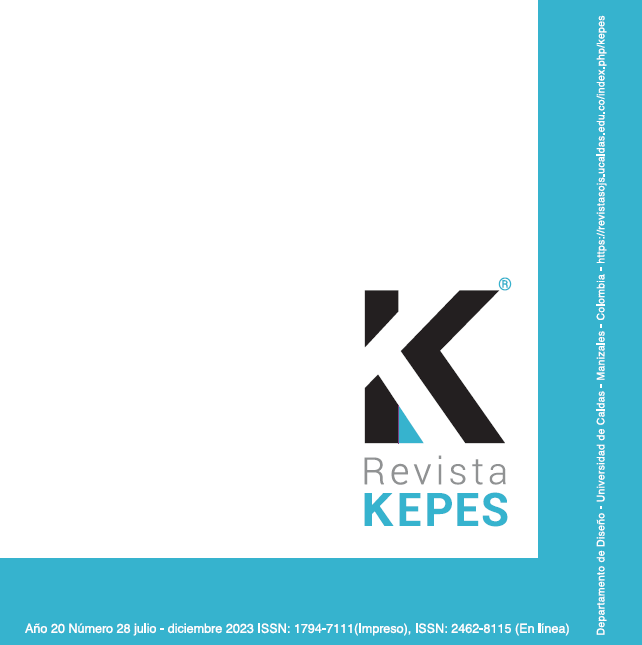Authors
Abstract
The objective of this article is to relate the cognitive processes of the designer in training with the development of prototypes of different levels of complexity in different phases of the design creation process. The theoretical proposal that supports the construction of such relationship approaches research-creation, staying away from the traditional view of design methods and focusing on the value acquired by the generation of prototypes for the actions of conceptualization and product development in the design process in coherence with a taxonomy of learning and knowledge. The proposed methodology is developed as case studies between 2019 and 2021 in classroom exercises in the Industrial Design program at the Universidad Antonio Nariño in spatial contexts (face-to-face and remote), accompanied by a Systematic Literature Review and a sample analysis of results of some of the 40 projects developed in the framework of the Emphasis Seminar subject. The projects presented in the analysis are the best methodologically structured and most outstanding in the processes of validation of prototypes that arose in the framework of research-creation processes in the classroom with a high level of rigor in the recording of results. The execution of this research made it possible to propose a categorization of variables that related cognitive processes with prototyping categories and to establish some considerations for the evaluation of prototypes at different moments of the training process of designers from the perspective of research-creation. Thus, then, as a conclusion of the research, important relationships were identified between the cognitive processes of designers in training and the levels of prototype development, being this a relevant category of study for design research.
References
Arrigoni, G. (2016). Epistemologies of prototyping: knowing in artistic research. Digital Creativity, 27(2), 99-112.
Ayala, C., Gasca, L. F., Gil, N. E., Kanek, M., Hernández, J. S., Hoyos, C. y Ramos, J. J. (2020). Verificación de la memorabilidad desde la investigación-creación en la Casa Museo Jorge Eliécer Gaitán. Editorial REDLIC.
Benjamin, W. (2019). La obra de arte en la época de su reproductibilidad técnica. Ediciones Godot.
Berkeley Letters & Science Arts & Humanities. (2020). Research in the Arts & Humanities. https:// artshumanities.berkeley.edu/research-arts-humanities
Bloom, B. S. y Krathwohl, D. R. (1956). Taxonomy of Educational Objectives: The Classification of Educational Goals, by a committee of college and university examiners. Handbook I: Cognitive Domain. Longmans, Green.
Borgdorff, H. (2010). El debate sobre la investigación en las artes. Cairon: revista de ciencias de la danza, 13, 25-46.
Borgdorff, H. (2012). The Conflict of the Faculties: Perspectives on Artistic Research and Academia. Leiden University Press. https://www.oapen.org/download?type=document&docid=595042
Breyer, G. (2007). Heurística del diseño. Nobuko.
Buchanan, R. (2010). Wicked Problems in Design Thinking. Kepes, 6, 7-35. http://vip.ucaldas. edu.co/kepes/downloads/Revista6_2.pdf
Buchanan, R. (2019). Systems thinking and design thinking: The search for principles in the world we are making. She Ji: The Journal of Design, Economics, and Innovation, 5(2), 85-104.
Careri, F., Pla, M., Hammond, P., y Piccolo, S. (2002). Walkscapes: el andar como práctica estética. Editorial Gustavo Gili.
Colciencias. (2016). Guía para el reconocimiento y medición de grupos de investigación e investigadores. Dirección de Fomento a la Investigación. http://www.colciencias.gov.co/sites/default/files/ckeditor_files/guia-reconocimiento-y-medicion-de-grupos-e-Investigadores.pdf
Coleman, B. y Goodwin, D. (2017). Designing UX: Prototyping: Because Modern Design is Never Static. SitePoint.
Cross, N. (2001). Designerly Ways of Knowing: Design Discipline versus Design Science. Design Issues, 17(3), 49-55. http://users.metu.edu.tr/baykan/arch467/Readings/Cross01.pdf
Cross, N. (2018). Developing design as a discipline. Journal of Engineering Design, 29(12), 691-708.
Debord, G. (1956). Theory of the derive. Les Lèvres Nues #9 (November 1956), reprinted in Internationale Situationniste #2 (December 1958).
Dorst, K. (2011). The Core of Design Thinking and its Application. Design Studies, 32, 521-532.https://www.sciencedirect.com/science/article/pii/S0142694X11000603
Dubberly, H (2005). ¡How do you design? Book unfinished. Dubberly design office. http://www.dubberly.com/articles/how-do-you-design.html
Frayling, C. (1993). Research in Art and Design (Vol. 1, No. 1, pp. 1-5). Royal College of Art.
Jones, J. C. (1992). Design methods. John Wiley & Sons.
Krippendorff, K. (2016). Design, an Undisciplinable Profession. https://repository.upenn.edu/handle/20.500.14332/2302
Martínez, N. (2014). Protothinking, pensamiento de diseño en acción. Ed. Nel Martínez estrategias de innovación. https://www.academia.edu/11078022/Protothinking1_0
Marzano, R. J. y Kendall, J. S. (2007). The New Taxonomy of Educational Objectives. Corwin
Press.
MinCiencias. (2020). Anexo 3. Investigación + Creación: Definiciones y Reflexiones. MinCiencias - Dirección de Generación de Conocimiento. https://minciencias.gov.co/sites/default/files/upload/convocatoria/anexo_3__la_investigacion_creacion_-_definiciones_y_reflexiones.pdf
Mínguez, H. (2014). La generación de conocimiento en la creación artística y su orientación en el ámbito universitario a nivel de posgrado. Revista Sonda: Investigación y Docencia en Artes y Letras, 3, 23-36.
Munari, B. (2008). Design as art. Penguin Books.
Munari, B. y Rodríguez, C. A. (1983). ¿Cómo nacen los objetos? Gustavo Gili.
Pérez-Orrego, N. (2017). Experiencias de conocimiento del diseño desde su relación con el arte. Kepes, 14(16), 121-146. https://doi.org/10.17151/kepes.2017.14.16.6
Pinilla, M. (2014). Dar sentido a las posibilidades: síntesis y prototipo en diseño. Iconofacto, 10(15), 22-34. https://dialnet.unirioja.es/descarga/articulo/5204359.pdf
RAD. (2021). Programas académicos de diseño. https://radcolombia.org/web/programas
Rey, A. (8 de julio de 2010). Pensar con prototipos: me uno a la reflexión (post-178). Amalio Rey | Blog de innovación con una mirada humanista. https://www.amaliorey.com/2010/07/08/pensar-con-prototipos-me-uno-a-la-reflexion-post-178/#sthash.rJeOhAx1.dpuf
Saikaly, F. (2003). Design re-thinking: some issues about doctoral programmes in design. In 5th International Conference of the European Academy of Design, Techné: Design Wisdom, the University of Barcelona (pp. 28-30).
Torres, I. (2015). Diseño crítico: de la transgresión a la autonomía. Máster Universitario en Investigación en Arte y Diseño - EINA/Universidad Autónoma de Barcelona.

 PDF (Español)
PDF (Español)
 FLIP
FLIP





















